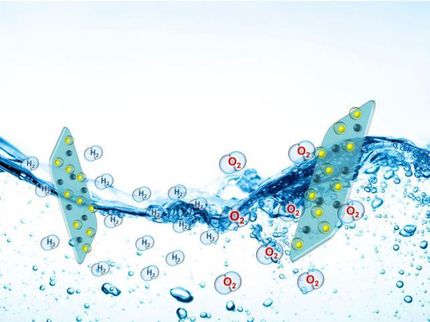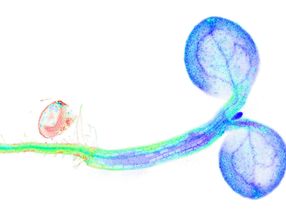Argonne chemist wins AWIS Innovator Award for nanoparticle research
The Chicago chapter of the Association for Women in Science (AWIS) granted its third annual Innovator Award to Tijana Rajh, group leader of the Nanobio Interfaces research group at Argonne National Laboratory’s Center for Nanoscale Materials. The award honors contributions to science in the Chicagoland area. Rajh received the award for her work studying semiconductor nanoparticles, a field with applications from solar power to cancer research.
Rajh cites Marion Thurnauer, a longtime Argonne scientist and former director of the Chemistry Division, as her mentor. “At the time she was hired at Argonne, and for the next eight years, she was the only female Ph.D. staff member of Argonne’s Chemistry Division,” Rajh said. “That experience prompted her to encourage broader searches for women to be represented in the Argonne job candidate pool.”
Rajh herself grew up in Yugoslavia, where, she says, it was more common for women to have careers in science. A friend of her mother’s brought Rajh to visit her workplace, a scientific institution much like Argonne. “I fell in love with it,” Rajh said. “There was absolutely no question what I was going to do with my life. And then when I came here,” she added, smiling, “I was hooked.”
While finishing her undergraduate physical chemistry degree at the University of Belgrade, a professor invited her to join a research project attempting to split water into hydrogen and oxygen molecules for fuel purposes. She didn’t know it, but it was the jumping-off point for a long career studying semiconductor nanoparticles — tiny particles made from materials which form the heart of modern electronics. Their photoactivity and stability is exactly what makes them good for many uses, from pollutant cleanup to medical imaging.
Rajh and the research team noticed that the particles of the same chemical composition appeared in different colors as researchers shrunk them smaller and smaller. Nanoparticles can change color, and other characteristics, with size: a quirk useful for many applications. “When you see it for the first time, it’s so amazing,” Rajh said. Together with her advisor Olga Micic and collaborator Art Nozik at the National Renewable Energy Laboratory, she authored one of the first three papers ever written about colloidal quantum dots (1985).
Thurnauer recruited Rajh in 1994, where she began studying how to use nanoparticles in a variety of applications: to remove heavy metal pollutants from the environment, write data to nanocircuits in computers, and link nanoparticles with biological materials.
For example, Rajh works with particles made of the semiconductor titanium dioxide (TiO2), which is white. When combined with organic compounds such as vitamin C or dopamine, which are also white, nanoparticles turn a brilliant red — indicating that the two materials are interacting at the molecular level. This discovery allowed her and her team to electronically link TiO2 particles with DNA and other biological molecules, opening a whole new dimension of possibilities. One of the team members, Elena Rozhkova, is working to apply the particles to cancer treatment. “She marks glioma cancer cells with TiO2 particles,” Rajh explained, “and doctors could use light of a certain energy to destroy only those marked cells, leaving healthy brain cells intact.”
At the core, though, Rajh loves basic science the best. “I love research, it’s so cool,” she said. “It’s like a puzzle. There’s a problem, and you look at it and start making connections, and very slowly the whole picture opens up.”
Rajh received her Ph.D. in 1986 from the University of Belgrade in Yugoslavia. Prior to working at CNM, she joined Argonne’s Chemistry Division in 1996 and has been a prolific researcher, co-authoring six papers in 2008 alone.
She is the third scientist to be recognized by the Association for Women in Science Chicago Area Chapter, a nonprofit organization dedicated to advancing women in the field of science. The group formed in 1971 and has since expanded nationwide. Chapters advocate for women in all scientific fields, publicize women’s achievements, and hold educational workshops for students. The Innovator Award recognizes achievements in science in the Chicagoland area.
Most read news
Other news from the department science
These products might interest you

NANOPHOX CS by Sympatec
Particle size analysis in the nano range: Analyzing high concentrations with ease
Reliable results without time-consuming sample preparation

Eclipse by Wyatt Technology
FFF-MALS system for separation and characterization of macromolecules and nanoparticles
The latest and most innovative FFF system designed for highest usability, robustness and data quality

DynaPro Plate Reader III by Wyatt Technology
Screening of biopharmaceuticals and proteins with high-throughput dynamic light scattering (DLS)
Efficiently characterize your sample quality and stability from lead discovery to quality control

Get the chemical industry in your inbox
By submitting this form you agree that LUMITOS AG will send you the newsletter(s) selected above by email. Your data will not be passed on to third parties. Your data will be stored and processed in accordance with our data protection regulations. LUMITOS may contact you by email for the purpose of advertising or market and opinion surveys. You can revoke your consent at any time without giving reasons to LUMITOS AG, Ernst-Augustin-Str. 2, 12489 Berlin, Germany or by e-mail at revoke@lumitos.com with effect for the future. In addition, each email contains a link to unsubscribe from the corresponding newsletter.





















































